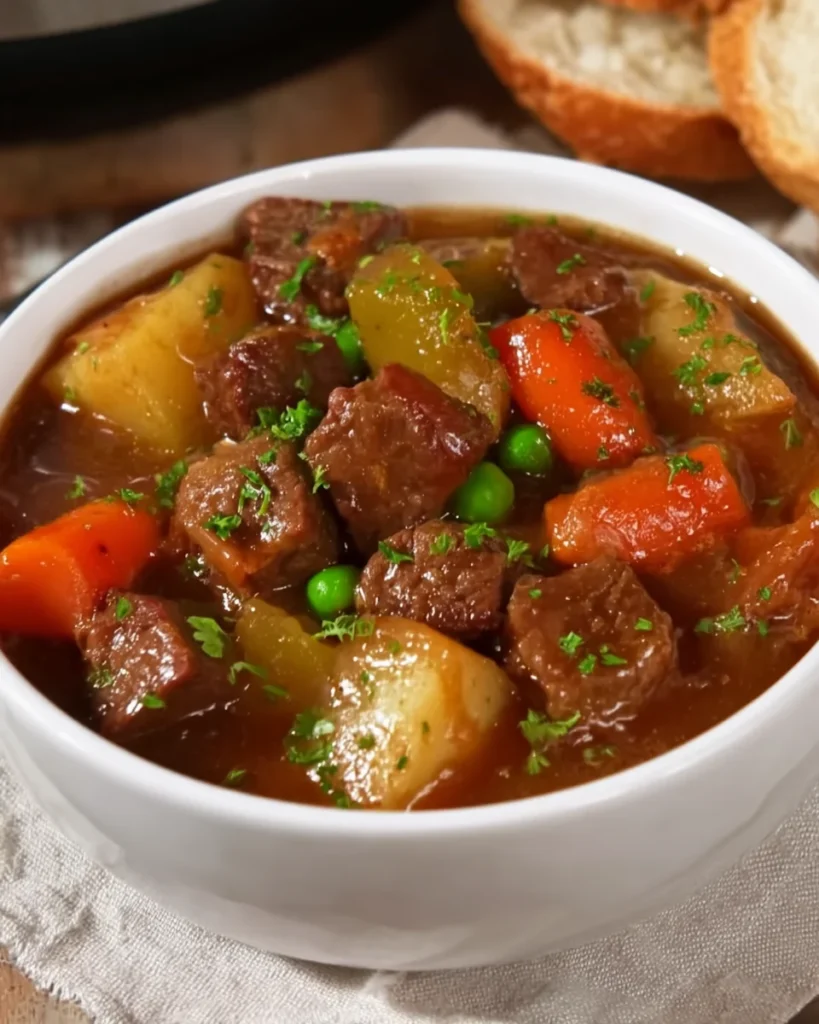
Warm up with a hearty slow cooker beef stew, filled with tender chunks of beef, potatoes, carrots, and rich, savory broth. This comforting dish is perfect for chilly days and comes together effortlessly in your slow cooker! Whether you’re hosting a family dinner or just need a cozy meal for yourself, this stew is sure to impress.
Why You’ll Love This Recipe
- Effortless Preparation: Simply toss your ingredients into the slow cooker and let it do the work for you.
- Rich Flavor: The combination of herbs and spices creates a deep, savory broth that enhances every bite.
- Versatile Ingredients: You can easily customize this stew by adding your favorite vegetables or swapping the beef for chicken.
- Perfect for Meal Prep: Make a big batch and enjoy leftovers throughout the week—it’s even better the next day!
- Family-Friendly: This hearty meal appeals to all ages, making it an excellent choice for family dinners.
Tools and Preparation
To make your slow cooker beef stew, you’ll need a few essential tools to ensure everything runs smoothly.
Essential Tools and Equipment
- Slow cooker
- Large skillet
- Cutting board
- Sharp knife
- Mixing bowl
Importance of Each Tool
- Slow cooker: This is the star of the show! It allows you to cook your stew slowly, resulting in tender meat and melded flavors.
- Large skillet: Ideal for browning the beef before adding it to the slow cooker, which adds depth to the flavor.
- Cutting board: Ensures safety and ease while chopping vegetables.
- Sharp knife: Makes quick work of cutting meat and veggies evenly.
Ingredients
For the Stew
- 2 pounds beef chuck, cut into 1-inch cubes
- 1 teaspoon salt
- 1 teaspoon ground black pepper
- 3 tablespoons all-purpose flour
Vegetables
- 4 medium potatoes, diced
- 4 large carrots, sliced
- 1 large onion, chopped
- 3 cloves garlic, minced
Broth Mixture
- 4 cups beef broth
- 2 tablespoons tomato paste
- 1 tablespoon Worcestershire sauce
- 1 teaspoon dried thyme
- 1 teaspoon dried rosemary
- 1 bay leaf
Garnish
- Fresh parsley, chopped (for garnish)
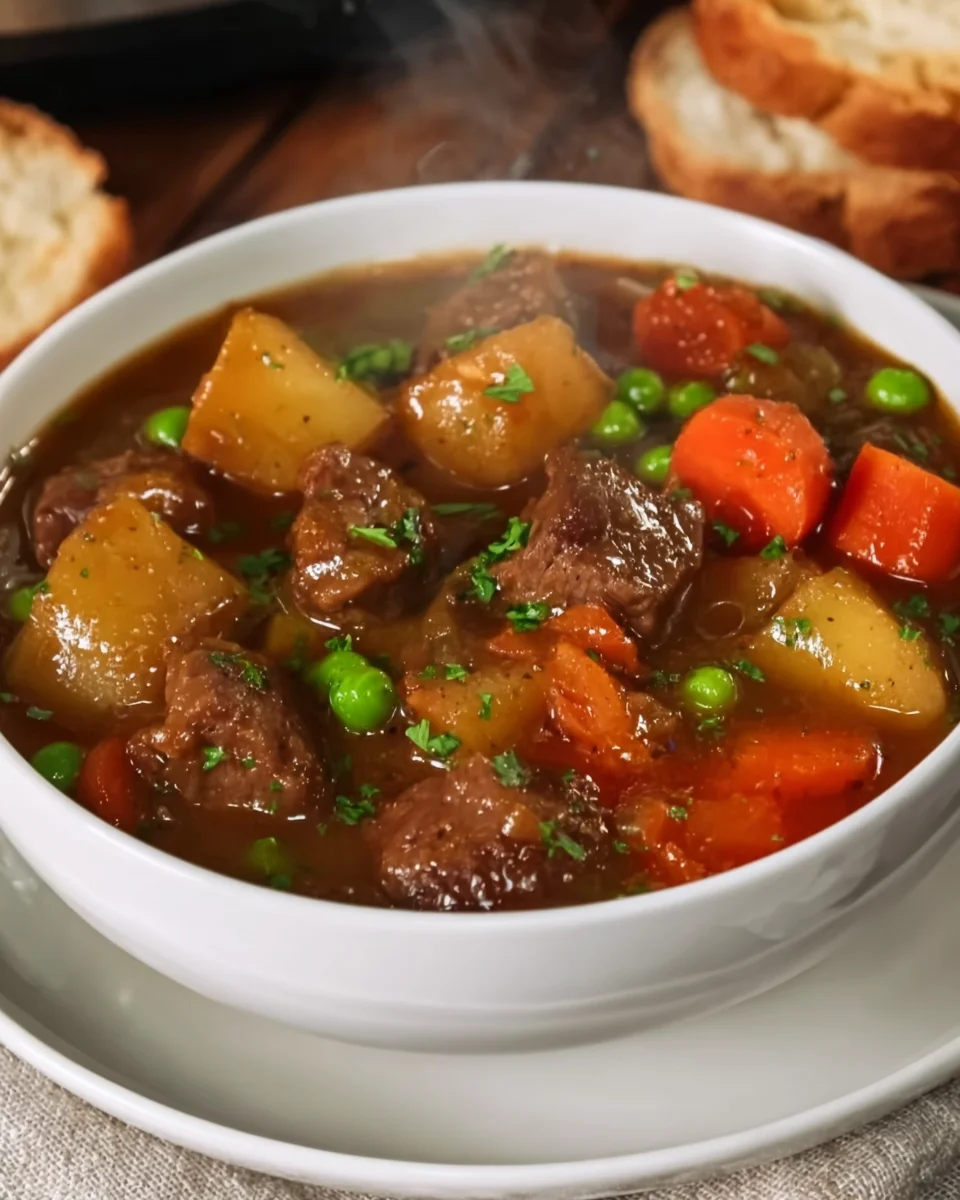
How to Make Slow Cooker Beef Stew
Step 1: Season and Brown the Beef
In a large bowl, season the beef cubes with salt and pepper. Sprinkle the flour over the beef and toss to coat evenly. Heat a large skillet over medium-high heat. Brown the beef in batches until browned on all sides, about 3-4 minutes per batch. Transfer the browned beef to the slow cooker.
Step 2: Add Vegetables
In the same skillet, add the onions, carrots, and garlic. Sauté for 2-3 minutes until the onions are translucent. Then, transfer this vegetable mixture to the slow cooker on top of the browned beef.
Step 3: Make the Broth
In a separate bowl, mix together the beef broth, tomato paste, Worcestershire sauce, thyme, rosemary, and bay leaf. Pour this mixture over the beef and vegetables in your slow cooker.
Step 4: Cook
Cover your slow cooker and cook on low for 7-8 hours or on high for 4-5 hours. Your goal is tender beef with flavors that have melded beautifully together.
Step 5: Serve
Remove the bay leaf before serving. Ladle your delicious stew into bowls and garnish with freshly chopped parsley. Enjoy this warm comfort food classic!
How to Serve Slow Cooker Beef Stew
Serving slow cooker beef stew is an opportunity to elevate this hearty dish and make it even more enjoyable. Here are some delicious ways to present your stew that will enhance its flavors and make mealtime special.
With Fresh Bread
- Crusty Baguette: Serve with slices of crusty baguette for dipping into the rich broth.
- Garlic Bread: A warm, buttery garlic bread pairs perfectly, adding a savory touch.
Over Rice or Noodles
- Fluffy White Rice: Spoon the beef stew over a bed of fluffy white rice to soak up all the delicious sauce.
- Egg Noodles: Serve over cooked egg noodles for a comforting, filling meal.
Topped with Garnishes
- Chopped Parsley: Sprinkle freshly chopped parsley on top for a pop of color and freshness.
- Grated Parmesan: Add grated Parmesan cheese for a rich, nutty flavor.
How to Perfect Slow Cooker Beef Stew
To create the best slow cooker beef stew, there are a few essential tips to keep in mind. These simple tricks can take your dish from good to great.
- Choose the Right Cut: Use beef chuck for tender, juicy results. It breaks down beautifully during slow cooking.
- Don’t Rush Browning: Take your time when browning the beef. This step adds depth and flavor to your stew.
- Layer Ingredients Wisely: Put vegetables at the bottom of the slow cooker and meat on top. This ensures even cooking.
- Season Generously: Don’t skimp on salt and pepper; they enhance the overall taste of the stew.
- Adjust Liquid as Needed: Depending on your preference, you can add more broth or water for a thinner consistency.
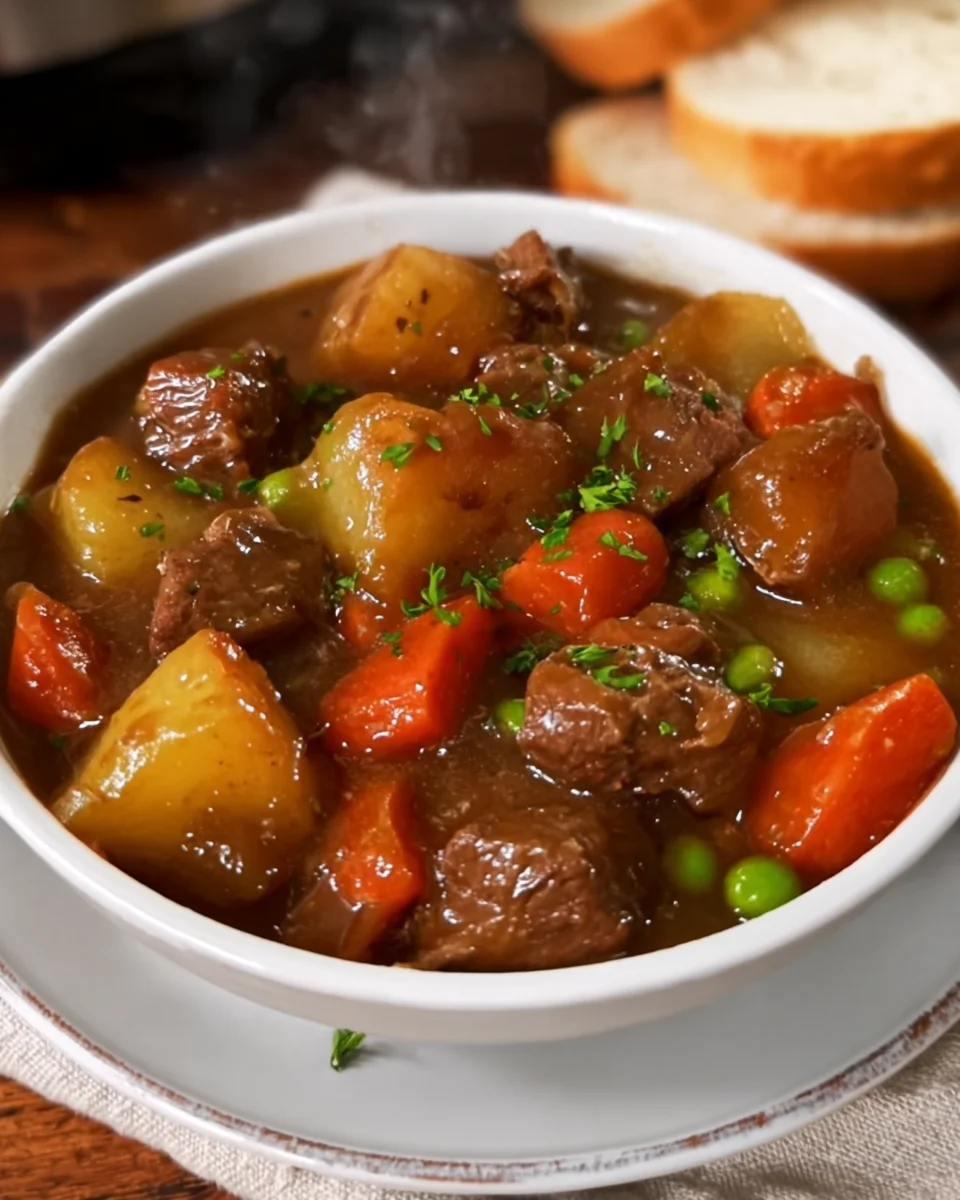
Best Side Dishes for Slow Cooker Beef Stew
Pairing side dishes with slow cooker beef stew can make your meal more complete and satisfying. Here are some great options that complement this comforting dish.
- Mashed Potatoes: Creamy mashed potatoes provide a smooth texture that pairs well with chunky stew.
- Steamed Green Beans: Lightly steamed green beans add a fresh crunch and vibrant color to your plate.
- Coleslaw: A tangy coleslaw offers a refreshing contrast to the rich flavors of the beef stew.
- Roasted Brussels Sprouts: Crispy roasted Brussels sprouts bring earthiness and a hint of sweetness.
- Cornbread: Sweet cornbread is perfect for soaking up extra broth while adding delightful flavor.
- Garden Salad: A simple garden salad with vinaigrette adds freshness and lightness to your meal.
Common Mistakes to Avoid
When making a slow cooker beef stew, there are common pitfalls to watch for. Here are some mistakes and how to avoid them.
- Skipping the browning step: Not browning the beef before adding it to the slow cooker can lead to a less flavorful stew. Take a few extra minutes to sear the beef for a richer taste.
- Overfilling the slow cooker: Filling your slow cooker too high can prevent even cooking and may cause spills. Keep the ingredients below the maximum fill line for best results.
- Neglecting seasoning adjustments: Underseasoning can result in bland stew. Always taste and adjust the seasoning before serving, especially after cooking.
- Using low-quality beef: Low-quality cuts of meat can make your stew tough and chewy. Choose chuck roast or similar cuts that will become tender during cooking.
- Ignoring cooking times: Cooking on high for too long can dry out the meat, while not cooking long enough on low can leave it tough. Follow recommended cooking times for perfect tenderness.
Storage & Reheating Instructions
Refrigerator Storage
- Store leftover slow cooker beef stew in an airtight container.
- It will last for about 3-4 days in the refrigerator.
- Make sure to cool it before placing it in the fridge.
Freezing Slow Cooker Beef Stew
- Freeze in a freezer-safe container or heavy-duty freezer bag.
- It keeps well for up to 3 months.
- Leave some space at the top of containers as liquids expand when frozen.
Reheating Slow Cooker Beef Stew
- Oven: Preheat to 350°F (175°C) and cover the stew in an oven-safe dish. Heat for about 30 minutes or until warmed thoroughly.
- Microwave: Place in a microwave-safe bowl, cover loosely, and heat on medium power for 2-3 minutes, stirring halfway through.
- Stovetop: Heat over medium-low heat in a saucepan, stirring occasionally until warmed through, about 10-15 minutes.
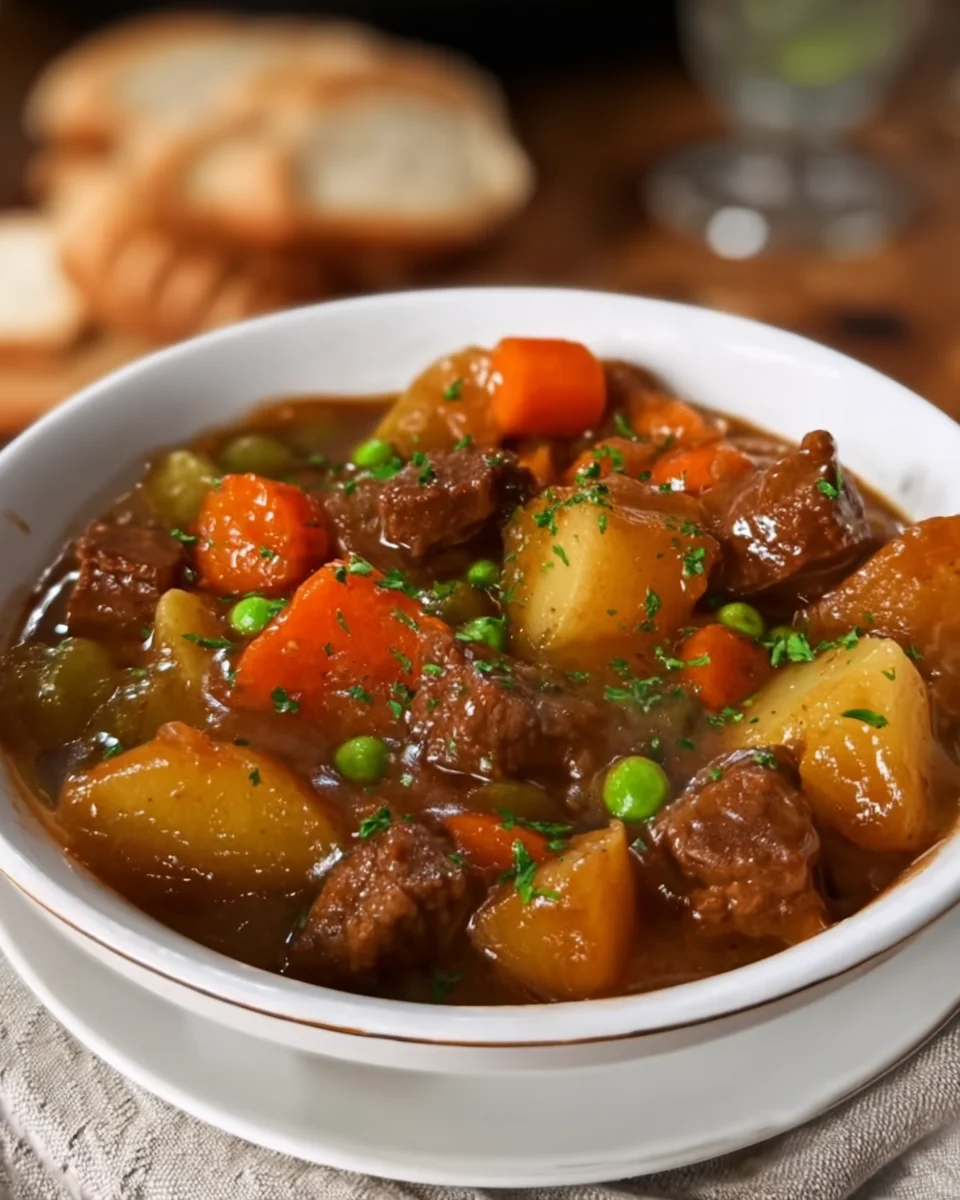
Frequently Asked Questions
What is Slow Cooker Beef Stew?
Slow cooker beef stew is a hearty dish made with tender chunks of beef, vegetables, and rich broth, cooked slowly to enhance flavors.
How long does Slow Cooker Beef Stew take to cook?
It takes approximately 7-8 hours on low or 4-5 hours on high. The longer cooking time allows the beef to become very tender.
Can I customize my Slow Cooker Beef Stew?
Absolutely! You can add various vegetables like peas or green beans or use different herbs and spices according to your preference.
What type of beef is best for Slow Cooker Beef Stew?
Beef chuck is ideal due to its marbling and tenderness when cooked slowly. Other cuts like brisket also work well.
Final Thoughts
Slow cooker beef stew is a comforting dish that warms you from the inside out. Its versatility allows you to customize ingredients based on what you have on hand. Give this recipe a try, and enjoy its heartwarming flavors!
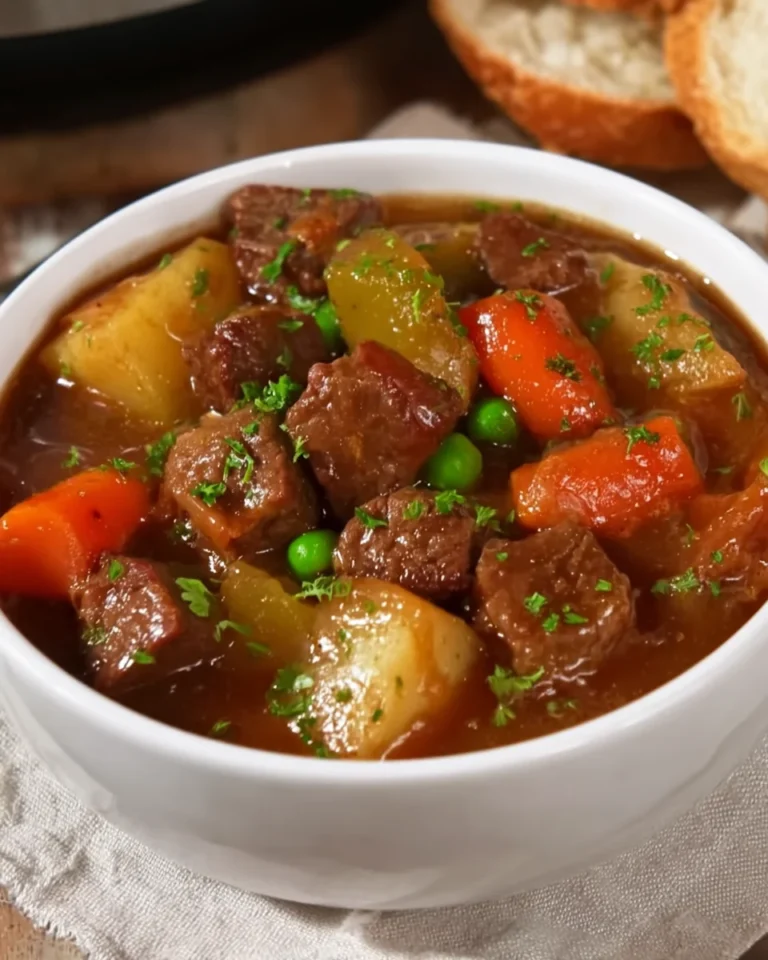
Slow Cooker Beef Stew
Warm up with a delightful Slow Cooker Beef Stew, the ultimate comfort food for chilly days. This hearty dish features tender chunks of beef simmered with potatoes, carrots, and aromatic herbs in a rich broth that melds flavors beautifully. Perfect for family dinners or cozy meals at home, this slow cooker recipe takes minimal effort—just toss in your ingredients and let the magic happen.
- Total Time: 7 hours 15 minutes
- Yield: Serves approximately 6
Ingredients
- 2 pounds beef chuck, cut into 1-inch cubes
- 4 medium potatoes, diced
- 4 large carrots, sliced
- 1 large onion, chopped
- 3 cloves garlic, minced
- 4 cups beef broth
- 2 tablespoons tomato paste
- 1 tablespoon Worcestershire sauce
- 1 teaspoon salt
- 1 teaspoon ground black pepper
- 3 tablespoons all-purpose flour
- 1 teaspoon dried thyme
- 1 teaspoon dried rosemary
- 1 bay leaf
- Fresh parsley for garnish
Instructions
- Season beef cubes with salt and pepper; toss with flour.
- Brown the beef in a skillet over medium-high heat and transfer to the slow cooker.
- Sauté onions, carrots, and garlic in the same skillet until onions are translucent; add to the slow cooker.
- Mix beef broth, tomato paste, Worcestershire sauce, thyme, rosemary, and bay leaf; pour over ingredients in the slow cooker.
- Cook on low for 7-8 hours or high for 4-5 hours until beef is tender. Remove bay leaf before serving and garnish with parsley.
- Prep Time: 15 minutes
- Cook Time: 7 hours
- Category: Main
- Method: Slow Cooking
- Cuisine: American
Nutrition
- Serving Size: 1 cup (240g)
- Calories: 320
- Sugar: 4g
- Sodium: 670mg
- Fat: 15g
- Saturated Fat: 6g
- Unsaturated Fat: 8g
- Trans Fat: 0g
- Carbohydrates: 25g
- Fiber: 4g
- Protein: 24g
- Cholesterol: 85mg
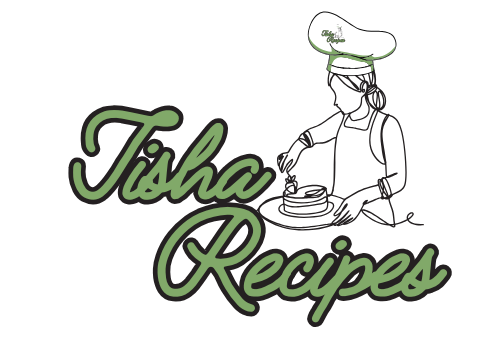



Leave a Comment